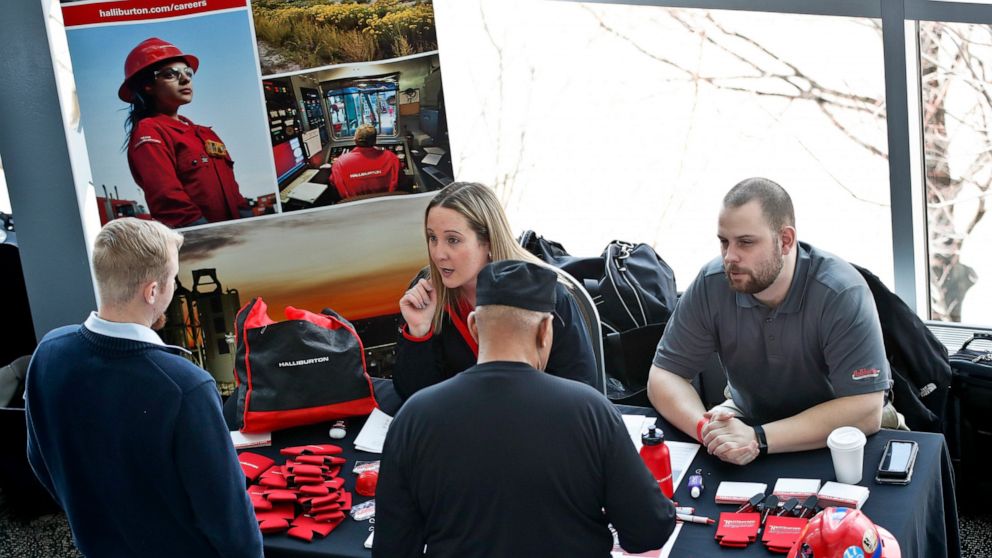
A random survey of 2,000 Americans has produced a surprisingly strong track record of forecasting the health of the job market over time.
At the moment, it points to a solid job gain for March in the monthly employment report the government will issue Friday. But it suggests that hiring could slow later this year.
The survey, a widely followed gauge of consumer confidence produced by the Conference Board, a business research group, goes beyond asking respondents about the state of the economy. It also asks whether they think jobs in their area are “plentiful” or “hard to get.”
The collective responses to those questions can foreshadow how job growth and the unemployment rate will move over time. When more people say jobs are plentiful and fewer say they’re hard to get, hiring typically rises and the unemployment rate falls. Wages are also more likely to increase.
“It’s a good predictor of how the labor market evolves,” said Joe Song, senior U.S. economist at Bank of America Merrill Lynch.
In July 2007, the percentage of Americans who said jobs were plentiful exceeded those who said they were hard to get by 11 points, indicating a good job market. The unemployment rate was a low 4.7% that month.
But the gap between the proportion of respondents saying jobs were plentiful and those saying they were hard to get then fell steadily — until it was barely positive in December that year, when the recession officially began. The unemployment rate remained at 4.7% or lower for four months before jumping to 5% in December and kept rising as the recession worsened.
The Conference Board’s measure plunged into negative territory in 2008 and 2009 as far more Americans said jobs were hard to get than plentiful. It bottomed at minus 46.1 in November 2009, one month after unemployment peaked at 10%, the highest rate in 26 years.
Similar downturns in the Conference Board’s data preceded previous recessions.
“It is highly correlated with unemployment,” Gad Levanon, chief economist at the Conference Board, said. “They have very similar turning points.”
The measure now indicates a sturdy job market but one that may weaken a bit. In March, far more Americans said they thought jobs were plentiful than hard to get, but the gap between the two narrowed by the most since the recession. The decline could still be a blip rather than evidence of job-market weakening, Levanon cautioned.
“I would wait a month or two to determine whether it is a turning point,” he added. “If it continues to decline, it would be a very concerning signal.”
The broader economy is itself sending mixed signals. Most indicators suggest slower growth this year compared with 2018. That would mean that hiring might also weaken from last year’s strong pace.
In February, employers added a surprisingly low 20,000 jobs, the fewest in nearly a year and a half, though that pullback likely reflected extreme weather and other temporary factors. Another weak jobs report Friday, though, would fuel concerns about a downshift in growth.
Consumers have shown caution so far this year. Retail sales fell in February, and a broader measure of consumer spending slipped in January, potentially reflecting a waning effect of the Trump administration’s tax cuts. Businesses have also reined in their spending on industrial machinery and other equipment and on factories and other buildings.
And in Europe and Asia, weaker economies have reduced demand for U.S. exports. Europe is on the brink of recession, with its factories shrinking in March at the fastest pace in six years, according to a private survey.
The U.S. trade war with China has weighed on the Chinese economy, which has hurt Southeast Asian nations that ship electronic components and other goods that are assembled into consumer products in China’s factories.
Economists now forecast that the U.S. economy will expand roughly 2% to 2.5% this year, down from 2.9% last year. Still, most economists have forecast a bounce-back in hiring in March to about 170,000 added jobs, according to data provider FactSet. The unemployment rate is expected to remain near a half-century low of 3.8%.
Some positive signs for the economy have emerged in recent weeks: Sales of both new and existing homes rose in February after declining last year. More Americans are applying for mortgages now that rates have fallen.
And some of the weakness in spending earlier this year likely reflected delays in issuing tax refunds because of the government shutdown. Refunds largely caught up with their pace in previous years in March, economists at Bank of America Merrill Lynch said, suggesting that spending may as well.
The low unemployment rate and steady hiring have also raised Americans’ paychecks. Average wages grew 3.4% in February compared with a year ago, the fastest such pace since the recession.
If wage growth continues to accelerate, it should fuel more spending and lift the economy in the coming months.





